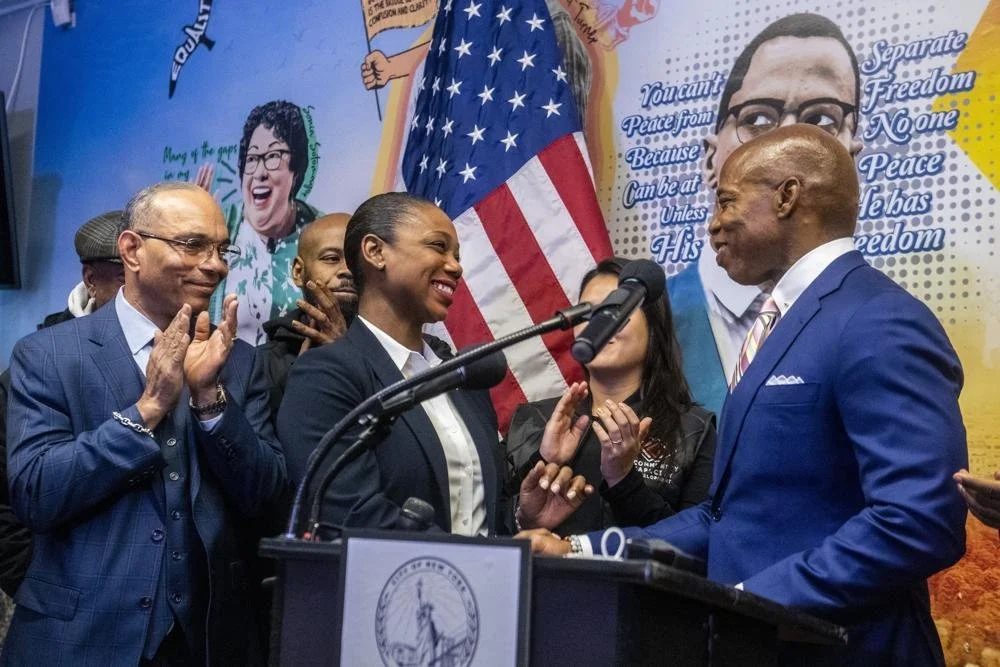NYPD brass defends mayor’s gun plan
/NYPD Commissioner Keechant Sewell (center) defended Mayor Eric Adams’ anti-gun violence plan to members of the City Council’s Committee on Public Safety on Wednesday, March 30, 2022. AP file photo by Brittainy Newman
By Jacob Kaye
City officials appearing before members of the City Council defended Mayor Eric Adams’ plan to combat gun violence throughout the five boroughs Wednesday.
Adams’ Blueprint to End Gun Violence was at the center of the hearing hosted by the council’s Committee on Public Safety Wednesday morning. The plan, which touches nearly every aspect of the criminal justice system, has been criticized by a number of councilmembers in the months since the mayor first introduced it. That criticism was apparent during Wednesday’s hearing, which, at times, was a tense affair.
NYPD Commissioner Keechant Sewell, a Queens native, Deputy Mayor for Public Safety Philip Banks and Deanna Logan, the director of the Mayor’s Office of Criminal Justice defended the plan, telling councilmembers its balanced approach will take guns off the streets and keep New Yorkers’ civil liberties intact.
“We are identifying, targeting, arresting and building strong prosecutions against gun carriers and trigger pullers in our city,” Sewell said. “But the NYPD's commitment to keeping this city safe is not built simply on arrests and incarceration. In fact, considerable focus and significant resources are dedicated to preemption and prevention as an alternative to enforcement.”
But a handful of councilmembers have yet to be convinced, with several progressive members of the body claiming that the Adams administration and the NYPD are relying on old policing tactics that the city moved away from in the past decade because of claims of civil violations and ineffectiveness.
Queens Councilmember Tiffany Caban, who ran for office on a pledge to divert funds from the NYPD, and Brooklyn Chi Ossé both got into verbal spats with Sewell during the hearing.
At one point, Caban asked NYPD brass about the data they relied on when deciding to create their recently rolled out neighborhood safety teams, an offshoot of the NYPD’s now-defunct anti-crime unit that was disbanded in 2020 amid racial justice protests and which accounted for a disproportionate amount of police killings. When Sewell told the councilmember that she would not provide the data but would discuss it with her at a later date, Caban accused the NYPD of ignoring the question.
“We’re not ignoring you, you want the answer to come, how you want the answer to come,” Banks said.
Caban responded by asking that they “provide the research” and “tell the public what you're relying on to make these really impactful important decisions that affect predominantly Black and brown, low-income New Yorkers.”
“I'm asking you to pass along the information you use to make these really consequential decisions,” she said. “And I have not gotten an answer as to whether or not you will do that and the lack of willingness for transparency is deeply deeply concerning.”
Adams introduced the anti-gun violence in plan in January, following the shooting deaths of two young NYPD officers. In addition to the neighborhood safety teams, which have been rolled out in several Queens precincts, the plan included putting more officers on the street, bringing more technology to the NYPD to identify people suspected of gun violence and increasing funding for community–based violence interrupters.
Several councilmembers questioned Banks and Sewell on the types of technology the NYPD is looking to expand, noting that facial recognition software has, in some cases, shown racial bias.
“The mayor is very big on looking and exploring technology as a way to fight crime,” Banks said. “No decision has been made at all on what device we're going to use, he has just asked us to explore and to look collectively and intensively into what can make New York City as safe as we possibly can, of course, constitutionally and being fair and being open.”
The Blueprint to End Gun Violence also laid out a number of policy proposals, including rolling back the bail reform laws and Raise the Age legislation, which makes it so 16- and 17-year-olds are tried as minors instead of as adults, as they were prior to the passage of the law.
While support for the policy requests, which can only be changed by state lawmakers, was waning when they were first introduced, Governor Kathy Hochul and Lt. Governor Brian Benjamin recently began circulating plans to work the changes into the state’s budget due April 1.
The effort to influence lawmakers ahead of the budget was furthered this week when Sewell made a trip to Albany to speak with senators and assemblymembers about giving judges the discretion to issue bail based on a defendant's perceived dangerousness to the community, the New York Post reported.




